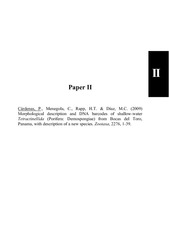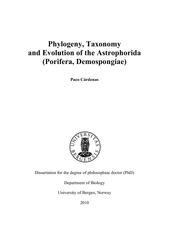| dc.contributor.author | Cárdenas, Paco | eng |
| dc.date.accessioned | 2010-08-13T12:27:39Z | |
| dc.date.available | 2010-08-13T12:27:39Z | |
| dc.date.issued | 2010-06-04 | eng |
| dc.identifier.isbn | 978-82-308-1543-4 (print version) | en_US |
| dc.identifier.uri | http://hdl.handle.net/1956/4020 | |
| dc.description.abstract | The Astrophorida (Porifera, Demospongiae) currently represent ca 660 extant species worldwide. In tropical and parts of warm temperate waters they are common at quite shallow depths, while in boreal/antiboreal and Arctic waters they are usually deep-water species. They have a very diverse external morphology (massive to thin encrusting, subspherical-, fan-, cupor irregularly-shaped) and display a wide array of external colors. They can be several meters large to a few millimeters thick. However, they all share the same spicule combination: small aster-shaped spicules (microscleres) associated with large four-rayed spicules (megascleres) called triaenes. This unique shared derived character (synapomorphy) is not found in any other Porifera groups. According to the last major morphological revision of the Astrophorida, five families are included in this order: Ancorinidae, Calthropellidae, Geodiidae, Pachastrellidae, and Thrombidae. To date, molecular phylogenetic studies including Astrophorida species are scarce and offer limited sampling. Phylogenetic relationships within this order are therefore for the most part unknown, hypotheses based on morphology largely untested and the spicule evolutionary processes poorly studied. This thesis presents five papers investigating the 1) taxonomy, 2) phylogeny and 3) evolution of the Astrophorida. 1) The first aim of this thesis was to build a molecular phylogeny on solid taxonomical grounds. The three first papers are integrative taxonomical and nomenclatural studies on Atlantic Astrophorida species, notably from the Caribbean coast of Panama and from Norway. In the course of these studies, three species were synonymized, two species were resurrected and two were new to science. This thesis also proposes a list of the North-East Atlantic/Mediterranean Sea Astrophorida species here considered valid. 2) The second aim of this thesis was to investigate the phylogenetic relationships within the Astrophorida with molecular data. The two following papers are molecular phylogeny analyses using a cytochrome c oxidase subunit I (COI) gene partial sequence and the 5’ end terminal part of the 28S rDNA, first considering the Geodiidae alone, then the Astrophorida. Sampling included all five families of this order, three ‘lithistid’ families of Astrophorida affinities as well as two putative Astrophorida (Alectona and Neamphius) still classified today in the Alectonidae, Hadromerida. The COI and 28S (C1-D2) datasets were concatenated in a single matrix containing a total of 152 taxa (29 genera, 2 sub-genera, 89 species) and 1,527 characters. The resulting tree showed that i) the Astrophorida was monophyletic, ii) the sub-orders Euastrophorida and Streptosclerophorida were both found polyphyletic, iii) the Calthropellidae were monophyletic (and found to be a subfamily of the Geodiidae), iv) the Geodiidae, the Ancorinidae and the Pachastrellidae appeared polyphyletic and had to be redefined, v) a new subfamily of the Geodiidae was revealed (Caminellinae subfam. nov.) and finally vi) some genera were found to be polyphyletic (Ecionemia, Erylus, Poecillastra, Penares, Rhabdastrella, Stelletta and Vulcanella). Based on these results, a revised classification of the Astrophorida is proposed, along with a key to the families, sub-families and incertae sedis. The use of a phylogenetic classification of the Astrophorida (following the principles of phylogenetic nomenclature and the rules of the PhyloCode) was also explored. 3) The third aim of this thesis was to investigate the evolution of Astrophorida sponge spicules, particularly diverse in this order. In the two last papers, spicule categories were mapped on the molecular phylogenetic trees. The main result was that spicule homoplasy is more common than what we expected: convergent evolution and secondary losses have happened many times, in all the clades, for megascleres and microscleres. The implications of these results are discussed with respect to the function of spicules, their evolution and the taxonomy of sponges. | en_US |
| dc.language.iso | eng | eng |
| dc.publisher | The University of Bergen | en_US |
| dc.relation.haspart | Paper I: Journal of the Marine Biological Association of the United Kingdom 87(6), Cárdenas, P.; Xavier, J.; Tendal, O. S.; Schander, C.; Rapp, H. T., Redescription and resurrection of Pachymatisma normani (Demospongiae, Geodiidae), with remarks on the genus Pachymatisma, pp. 1511-1525. Copyright 2007 Marine Biological Association of the United Kingdom. Published by Cambridge University Press. Reproduced with permission. Published version. The published version is also available at: <a href="http://dx.doi.org/10.1017/S0025315407058286" target="_blank">http://dx.doi.org/10.1017/S0025315407058286</a> | en_US |
| dc.relation.haspart | Paper II: Zootaxa 2276, Cárdenas, P.; Menegola, C.; Rapp, H. T.; Díaz, M. C., Morphological description and DNA barcodes of shallow-water Tetractinellida (Porifera: Demospongiae) from Bocas del Toro, Panama, with description of a new species, pp. 1-39. Copyright 2009 Magnolia Press. Reproduced with permission. Published version. | en_US |
| dc.relation.haspart | Paper III: Cárdenas, P.; Rapp, H. T., 2010, A review of Astrophorida with streptasters (Porifera, Demospongiae) from Norway, new records and a new species. Full text not available in BORA. | en_US |
| dc.relation.haspart | Paper IV: Zoologica Scripta 39(1), Cárdenas, P.; Rapp, H. T.; Schander, C.; Tendal, O. S., Molecular taxonomy and phylogeny of the Geodiidae (Porifera, Demospongiae, Astrophorida) — combining phylogenetic and Linnaean classification, pp. 89-106. Copyright 2009 The Authors. Journal compilation 2009 The Norwegian Academy of Science and Letters. Published by Wiley-Blackwell. Full text not available in BORA due to publisher restrictions. The published version is available at: <a href="http://dx.doi.org/10.1111/j.1463-6409.2009.00402.x" target="_blank"> http://dx.doi.org/10.1111/j.1463-6409.2009.00402.x</a> | en_US |
| dc.relation.haspart | Paper V: Cárdenas, P.; Xavier, J.; Reveillaud, J.; Schander, C.; Rapp, H. T., 2010, Molecular taxonomy and phylogeny of the Astrophorida (Porifera, Demospongiae) — an unexpected high level of spicule homoplasy. Full text not available in BORA. | en_US |
| dc.title | Phylogeny, Taxonomy and Evolution of the Astrophorida (Porifera, Demospongiae) | en_US |
| dc.type | Doctoral thesis | |
| dc.rights.holder | The author | en_US |
| dc.rights.holder | Copyright the author. All rights reserved | en_US |
| dc.subject.nsi | VDP::Matematikk og Naturvitenskap: 400::Basale biofag: 470 | nob |


